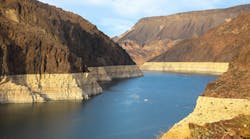When engineering firm Shive-Hattery began work to expand a parking facility for an industrial client, it needed to comply with Iowa city’s requirements to reduce total suspended solids (TSS) by 80 percent for the 1.25-inch design storm.
As most of the site had impervious cover connected to an adjacent river by a stormwater conveyance, the firm’s treatment options were limited to structural devices. As part of the local requirements, the installation already needed to use an oil water separator — but, as designed, it would not be able to meet the TSS reductions alone.
Ultimately, the firm would select a simple hydrodynamic device and water quality hood from Best Management Products Inc. (BMP) to reduce pollution from stormwater discharges.
BMP’s Turbo Plate® is a simple hydrodynamic device that reduces pollution from stormwater discharges. Designed to significantly improve the performance of the SNOUT® water quality hood in an online sump structure, these stainless-steel plates decrease the velocity and turbulence of stormwater flows to increase sediment capture.
To appreciate how a simple hybrid-baffle device can positively impact solids removal from stormwater, it is helpful to understand a few simple principles of flow dynamics. A common formula used to calculate uniform flow rate is Q=VA, where Q is flow rate (e.g., gallons per minute, liters per second), V is velocity (e.g., feet per second, meters per second), and A is area that the flow moves past, either length times width or based on the diameter (e.g., square feet, square inches, square meters). Therefore, for a given flow rate, increasing the area that the fluid moves past will also reduce the velocity as V=Q/A.
By increasing the area that the flow moves past, baffles can reduce the velocity which relates to turbulence, an enemy of allowing particles to settle. Simply, if flow is fast, the liquid will have a lot of kinetic energy, which causes suspended particles to move in a random and chaotic fashion, preventing them from settling.
Using a combination of a solid baffle and perforated baffles, the Turbo Plate reduces velocity in two ways. First, flow is re-directed with a solid baffle at the inlet pipe, preventing the flow from going straight through to the exit pipe and increasing the length of the flow path. Second, the redirected flow encounters the holes in the perforated baffles, which again increases the length of the surface that the flow must move past — the flow needs to move past the length of the circumference of each circular hole.
In an installation, the first Turbo Plate is solid and positioned adjacent to the inlet pipe. The solid plate deflects the flow to one or two perforated plates that improve the separation characteristics of the structure as described above. The calming effect knocks down sediment particles, which results in a significant increase in fine solids removal. The flow then exits the structure from underneath the SNOUT water quality hood.
The SNOUT, when paired with Turbo-Plates, showed an 80 percent sediment removal rate in 3rd party testing at Alden Labs in Holden, Mass., for a sediment sample with a 50-1000 micron particle size distribution at 225 gallons per minute.
To hydrodynamically reduce pollution in stormwater in a practical fashion, pollutants should be separated into both floatable and sinkable layers, where can be collected and later removed during maintenance procedures. To create these layers, the Turbo Plates help to reduce velocity and turbulence while the SNOUT acts as a skimmer in a sump-style structure.
These components are used in non-proprietary structures made by local concrete precast manufacturers or poured on site by contractors, resulting in significant cost savings. In some cases, these components can be used to retrofit existing sump style structures, resulting in even more savings. BMP provides free design recommendations on sizing the structures, as well as performance modeling to predict performance given catchment data and structure dimension inputs.
One team member working on Shive-Hattery’s project was Greg Schaapveld, PE, civil group leader and civil engineer at firm’s Bettendorf, Iowa, office. He was searching for an option that would meet requirements while limiting additional expense for the client.
Schaapveld’s team, working with a BMP engineer, were able to modify the design and retrofit he structure with SNOUTs, Bio-Skirts, and Turbo-Plates that increased the performance to satisfy the local requirements.
The two-chamber structure design was modified to make the first chamber a pre-treatment section and the second chamber a polishing section. The first chamber with a 15-inch ID inlet pipe was modified to close the weir on the bottom of the structure and open a 15-inch orifice, creating a 4 foot deep sump. The inlet pipe was fitted with a TP1845S solid Turbo Plate and the sides of the structure each got a TP1890 perforated Turbo Plate. The second chamber received another 24F SNOUT over the 15-inch outlet pipe and two Bio-Skirts for oils in front of the SNOUT.
This design is highly effective, as the first structure knocks down sediment and gross-particles, and then laminarizes the flow into the second structure. In the second chamber, the Bio-Skirt attracts hydrocarbons and the second SNOUT further polishes the outflow.
Published in Stormwater magazine, November 2022.
About the Author
T.J. Mullen
T.J. Mullen is president and co-founder of Best Management Products Inc., manufacturers of TurboPlate®, SNOUT®, and Bio-Skirt® products. Learn more at bmpinc.com.


